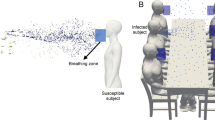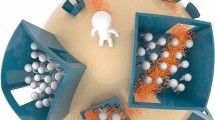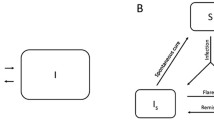Abstract
The integrated effects of production, dispersal, deposition, survival and infectiousness of inoculum are manifest in the disease severity it is able to cause under the specific conditions of environmental and host factors. Evaluation of these components and of their integrated effects is often so difficult that they constitute the “black boxes” in many epidemiological analyses. There are no research techniques that will eliminate completely these black boxes. However, there are some direct and indirect approaches that may improve quantitative assessment of the individual components and their integrated action.
Access this chapter
Tax calculation will be finalised at checkout
Purchases are for personal use only
Preview
Unable to display preview. Download preview PDF.
Similar content being viewed by others
References
Anon (1983) In: Johnston A, Booth C (eds) Plant pathologist’s pocketbook, 2nd edn. Commonwealth Agriculture Bureaux, Slough, England, pp 408–409
Aust HJ, Kranz J (1974) Eine automatische Sporenfalle für den Gebrauch in Klimaschränken. Angew Bot 48: 267–272
Aylor DE (1979) Dispersal in time and space: aerial pathogens. In: Horsfall JG, Cowling EB (eds) Plant disease, advanced treatise, vol 2. Academic Press, London, pp 159–180
Bainbridge A, Stedman OJ (1979) Dispersal of Erysiphe graminis and Lycopodium clavatum spores near to the source is a barley crop. Ann Appl Biol 91: 187–198
Bartlett JT, Bainbridge A (1978) Volumetric sampling of microorganisms in the atmosphere. In: Scott PR, Bainbridge A (eds) Plant disease epidemiology. Blackwell Scientific Publ, Oxford, England, pp 23–30
Bashi E, Aylor DE (1983) Survival of detached sporangia of Peronospora destructor and Peronospora tabacina. Phytopathology 73: 1135–1139
Bashi E, Ben-Joseph Y, Rotem J (1982) Inoculum of Phytophthora infestans and the development of potato late blight epidemics. Phytopathology 72: 1043–1047
Burleigh JR, Romig RW, Roelfs AP (1969) Characterization of wheat rust epidemics by numbers of uredia and numbers of urediospores. Phytopathology 59: 1229–1237
Caesar A J, Pearson RC (1983) Environmental factors affecting survival of ascospores of Sclerotinia sclerotiorum. Phytopathology 73: 1024–1030
Casselman TW, Berger RD (1970) An improved portable automatic sampling spore trap. Proc Fla State Hortic Soc 83: 191–195
Chamberlain AC (1975) The movement of particles in plant communities. In: Monteith JC (ed) Vegetation and the atmosphere: 1. principles. Academic Press, London, pp 155–203
Edmonds RL (1972) Collection efficiency of rotorod samplers for sampling fungus spores in the atmosphere. Plant Dis Rep 56: 704–708
Edmonds RL, Hinshaw RW, Leslie KB (1984) A 24-hour deposition sampler for spores of Heterobasidion annosum. Phytopathology 74: 1032–1034
Eversmeyer MG, Kramer CL, Collins TI (1976) Three suction-type spore samplers compared. Phytopathology 66: 62–64
Faulkner MJ, Colhoun J (1977) An automatic spore trap for collecting pycnidiospores of Leptosphaeria nodorum and other fungi from the air during rain and maintaining them in a viable condition. Phytopathol Z 89: 50–59
Fitt BDL (1983) Evaluation of samplers for splash-dispersed fungus spores. EPPO Bull 13: 57–61
Gadoury DM, MacHardy WE (1983) A recording volumetric spore trap. Phytopathology 73: 1526–1531
Gottwald TR, Tedders WL (1985) A spore and pollen trap for use on aerial remotely piloted vehicles. Phytopathology 75: 801–807
Gregory PH (1973) The microbiology of the atmosphere, 2nd edn. Leonard Hill, London
Hartmann H, Sutton JC, Thurtell GW (1982) An apparatus for accurate control of atmospheric water potentials in studies of foliar plant pathogens. Phytopathology 72: 914–916
Hirst JM (1952) An automatic volumetric spore trap. Ann Appl Biol 39: 257–265
Hirst JM (1959) Spore liberation and dispersal. In: Holton CS (ed) Plant pathology–problems and progress, 1908–1958. Univ of Wisconsin Press, Madison, WI, pp 529–538
Honda Y, Yunoki T (1977) Control of Sclerotinia disease of greenhouse eggplant and cucumber by inhibition of development of apothecia. Plant Dis Rep 61: 1036–1040
Husain SM (1963) An automatic suction-impaction type spore trap and its use with onion blotch Alternaria. Phytopathology 53: 382–387
Kramer CL, Eversmeyer MG, Collins TI (1976) A new 7-day spore sampler. Phytopathology 66: 60–61
Landahl HD, Herrmann RG (1949) Sampling of liquid aerosols by wires, cylinders and slides, and efficiency of impaction of the droplet. J Colloid Sci 4: 103–136
May KR (1967) Physical aspects of sampling airborne microbes. In: Gregory PH, Monteith JL (eds) Airborne microbes. Cambridge Univ Press, Cambridge, England, pp 60–88
Morris JCT (1982) A simple automatic volumetric spore trap. Bull Br Mycol Soc 16: 151–154
Perkins WA (1957) The rotorod sampler. 2nd Semiannual Rep Aerosol Lab, Dept of Chemistry and Chemical Engng, Stanford Univ CA 186, pp 1–66
Rotem J (1968) Thermoxerophytic properties of Alternaria porri f. sp. solani. Phytopathology 58: 1284–1287
Rotem J, Aylor DE (1984) Development and inoculum potential of Peronospora tabacina in the fall season. Phytopathology 74: 309–313
Rotem J, Wooding B, Aylor DE (1985) The role of solar radiation, especially ultraviolet, in the mortality of fungal spores. Phytopathology 75: 510–514
Schein RD (1964) Comments on the moisture requirements of fungus germination. Phytopathology 54: 1427
Schwarzbach E (1979) A high throughput jet trap for collecting mildew spores on living leaves. Phytopathol Z 94: 165–171
Sutton TB, Jones AL (1976) Evaluation of four spores traps for monitoring discharge of ascospores of Venturia inaequalis. Phytopathology 66: 453–456
Waggoner PE (1983) The aerial dispersal of the plant pathogens of plant disease. Philos Trans R Soc Lond B Biol Sci 302: 451–462
Wili GM (1985) Comparison of the designs of two volumetric spore traps. Phytopathology 75: 380
Winston PW, Bates DH (1960) Saturated solutions for the control of humidity in biological research. Ecology 41: 232–237
Zuck, MG, Caruso FL (1984) A volumetric spore trap designed for monitoring Venturia inaequalis spore release in apple scab management programs. Phytopathology 74: 796 (abstr)
Author information
Authors and Affiliations
Editor information
Editors and Affiliations
Rights and permissions
Copyright information
© 1988 Springer-Verlag Heidelberg
About this chapter
Cite this chapter
Rotem, J. (1988). Quantitative Assessment of Inoculum Production, Dispersal, Deposition, Survival and Infectiousness in Airborne Diseases. In: Kranz, J., Rotem, J. (eds) Experimental Techniques in Plant Disease Epidemiology. Springer, Berlin, Heidelberg. https://doi.org/10.1007/978-3-642-95534-1_6
Download citation
DOI: https://doi.org/10.1007/978-3-642-95534-1_6
Publisher Name: Springer, Berlin, Heidelberg
Print ISBN: 978-3-642-95536-5
Online ISBN: 978-3-642-95534-1
eBook Packages: Springer Book Archive




